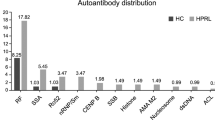Abstract
High serum prolactin (PRL) levels and even hyperprolactinemia are a common finding in human immunodeficiency virus (HIV) infection. However, little is known regarding the mechanisms that may contribute to the rise of PRL. We measured serum PRL levels in 54 HIV-infected and 85 healthy age-matched men. The association between PRL levels among anti-PRL autoantibodies and other clinical variables in HIV-infected men was studied. We also evaluated the changes in serum PRL levels by chromatographic separation (affinity with protein G and gel filtration) after a 10-mg iv bolus of metoclopramide. HIV-infected men had higher serum PRL levels compared with healthy men. Sera from 9 of the 54 (16.7%) HIV-infected men were found to have hyperprolactinemia. Moreover, the anti-PRL autoantibody was present in four of nine (44.4%) HIV-infected men with hyperprolactinemia; it was also associated with hyperprolactinemic status. Serum total PRL levels were higher in HIV-infected men with anti-PRL autoantibodies than hyperprolactinemic HIV-infected men without anti-PRL autoantibodies; by contrast, free PRL levels were lower. In HIV-infected men with anti-PRL autoantibodies, gel filtration showed that big big PRL isoform was present as the predominant circulating form of PRL throughout each measurement after iv metoclopramide. By contrast, the predominant isoform of PRL in serum from healthy men and HIV-infected men who were anti-PRL autoantibody negative was little PRL. On the other hand, high serum total PRL levels were observed at each measurement throughout the metoclopramide test in HIV-infected men with anti-PRL autoantibodies; however, the serum free PRL levels were similar to those found in subjects without anti-PRL autoantibodies. These data demonstrated that anti-PRL autoantibodies are associated with hyperprolactinemic status in HIV-infected subjects, particularly in those with high serum PRL levels.
Similar content being viewed by others
References
Dobs, A. S., Dempsy, M. A., Ladenson, P. W., and Polk, B. F. (1988). Am. J. Med. 84, 611–616.
Merenich, J. A., McDermott, M. T., Asp, A. A., Harrison, S. M., and Kidd, G. S. (1990). J. Clin. Endocrinol. Metab. 70, 566–571.
Croxson, T. S., Chapman, W. E., Miller, L. K., Levit, C. D., Senie, R., and Zumoff, B. (1989). J. Clin. Endocrinol. Metab. 68, 317–321.
Graef, A. S., Gonzalez, S. S., Baca, V. R., et al. (1994). Clin. Immunol. Immunopathol. 72, 390–393.
Montero, A., Giovannoni, A. G., and Sen, L. (2000). Medicina (Buenos Aires) 60, 427–430.
Hutchinson, J., Murphy, M., Harries, R., and Skinner, C. J. (2000). Lancet 356, 1003–1004.
Shaw, J. A., Sawers, H. A., Strachan, F. M., and Bevan, J. S. (1997). J. R. Soc. Med. 90, 274–275.
Kleinberg, D. L., Noel, G. L., and Frantz, A. G. (1977). N. Engl. J. Med. 296, 589–600.
Lane, H. C., Masur, H., Edgar, L. C., Whalen, G., Rook, A. H., and Fauci, A. S. (1983). N. Engl. J. Med. 309, 453–458.
Muller, S., Richalet, P., Laurent-Crawford, A., et al. (1992). AIDS 6, 933–942.
Kordossis, T., Piha, L., Guialis, A., Kosmopoulou, O., Tzioufas, A. G., and Moutsopoulos, H. M. (1997). Clin. Exp. Rheumatol. 5, 185–188.
Massabki, P. S., Accetturi, C., Nishie, I. A., da Silva, N. P., Sato, E. I., and Andrade, L. E. (1997). AIDS 11, 1845–1850.
Kopelman, R. G. and Zolla-Pazner, S. (1988). Am. J. Med. 84, 82–88.
Kaye, B. R. (1989). Ann. Intern. Med. 111, 158–167.
Blanco-Favela, F., Quintal-Alvarez, G., and Leaños-Miranda, A. (1999). J. Rheumatol. 26, 55–59.
Leaños, A., Pascoe, D., Fraga, A., and Blanco-Favela, F. (1988). Lupus 7, 398–403.
Leaños-Miranda, A., Pascoe-Lira, D., Chávez-Rueda, K. A., and Blanco-Favela, F. (2001). J. Rheumatol. 28, 1546–1553.
Hattori, N., Ishihara, T., Ikekubo, K., Moridera, K., Hino, M., and Kurahachi, H. (1992). J. Clin. Endocrinol. Metab. 75, 1226–1229.
Leite, V., Cosby, H., Sobrinho, L. G., Fresnoza, A., Santos, M. A., and Friesen, H. G. (1992). Clin. Endocrinol. 37, 365–372.
Cavaco, B., Leite, V., Santos, M. A., Arranhado, E., and Sobrinho, L. G. (1995). J. Clin. Endocrinol. Metab. 80, 2342–2346.
Pascoe-Lira, D., Duran-Reyes, G., Contreras-Hernández, I., Manuel-Apolinar, L., Blanco-Favela, F., and Leaños-Miranda, A. (2001). J. Clin. Endocrinol. Metab. 86, 924–929.
Hattori, N., Ikekubo, K., Ishihara, T., Moriderea, K., Hino, M., and Kurahachi, H. (1994). Eur. J. Endocrinol. 130, 438–445.
Garnier, P. E., Aubert, M. L., Kaplan, S. I., and Grumbach, M. M. (1978). J. Clin. Endocrinol. Metab. 47, 1273–1281.
Leaños-Miranda, A., Pascoe-Lira, D., Chávez-Rueda, K. A., and Blanco-Favela, F. (2001). J. Clin. Endocrinol. Metab. 86, 2619–2624.
Leaños-Miranda, A., Chávez-Rueda, K. A., and Blanco-Favela, F. (2001). Arthritis Rheum. 44, 866–875.
Pellegrini, I., Lebrun, J. J., Ali, S., and Kelly, A. P. (1992). Mol. Endocrinol. 6, 1023–1031.
Montgomery, D. W., Shen, G. K., Ulrich, E. D., Steiner, L. L., Parrish, P. R., and Zukoski, C. F. (1992). Endocrinology 131, 3019–3026.
Matera, L. (1997). Neuroimmunomodulation 4, 171–180.
Larrea, F., Martínez-Castillo, A., Cabrera, V., et al. (1997). J. Clin. Endocrinol. Metab. 82, 3664–3669.
Hatfill, S. J., Kirby, R., Hanley, M., Ribicki, E., and Bohm, L. (1990). Leuk. Res. 14, 57–62.
Parra, A., Ramírez-Peredo, J., Coutiño, B., et al. (1999). J. Lab. Clin. Med. 133, 70–74.
Centers for Disease Control and Prevention. (1992). MMWR Morb. Mortal. Wkly. Rep. 41(RR-17), 1–19.
Leaños-Miranda, A., Pascoe-Lira, D., Chávez-Rueda, K. A., and Blanco-Favela, F. (2001). Lupus 10, 340–345.
Author information
Authors and Affiliations
Corresponding author
Rights and permissions
About this article
Cite this article
Leaños-Miranda, A., Contreras-Hernández, I. Antiprolactin autoantibodies are associated with hyperprolactinemic status in men infected with human immunodeficiency virus. Endocr 19, 139–146 (2002). https://doi.org/10.1385/ENDO:19:2:139
Received:
Revised:
Accepted:
Issue Date:
DOI: https://doi.org/10.1385/ENDO:19:2:139




